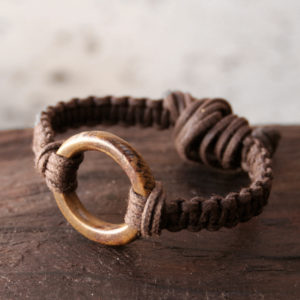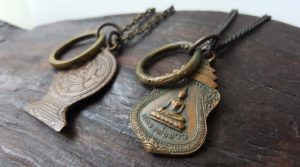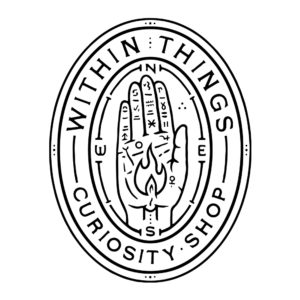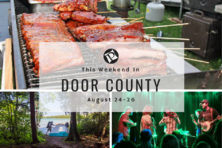Perfectly Imperfect: Q&A with scavenger artist Ryan Keane
- Share
- Tweet
- Pin
- Share

Questions by Sally Collins
Jeweler Ryan Keane, a self-described “scavenger,” creates eclectic old world pieces that appear museum-worthy or, at the very least, created for the set of an epic period film. Using materials from across the globe, as far as Japan, Africa, Thailand, and his own backyard, he relishes making wearable art that has a story.
Sally Collins (SC): Ryan, how did you become interested in jewelry making?
Ryan Keane (RK): My earliest explorations with jewelry came from an interest in gemstones. I began collecting a lot of loose gemstones in my early twenties. I was interested in the science behind how they were formed and the variety of different textures and shapes they took along the way. I remember walking into a bead/gem shop for my first time and thinking it would be interesting to be able to wear some of these unique stones. I ended up buying a bunch of jewelry wire, clasps and stone beads, and primarily making jewelry for family and friends. Later on down the road, my wife and I got into selling the pieces we had created at local art events.
SC: Did anyone or anything inspire you as you honed your craft?
RK: I was living in Arizona when I began making jewelry. There are a lot of incredible metal and found object artists working there, and the barren desert landscape seemed to lend itself perfectly to metal sculpture. The way metal aged over time, from the rust patterns to various colors the patina would develop, was like a living work of art. A little while after I became interested in jewelry design, I started working at a bead shop in Arizona that cast its own jewelry components in sterling silver and bronze. It taught me a lot about design and turned me on to a wide variety of materials (antler, waxed linen, seed pods) that I’d never thought of working with before.

SC: I see your pieces are inspired by places and cultures from all over the world — Thailand, Greece, Italy — how do you choose your designs? Have you visited these places?
RK: Sadly, I’ve not been to any of the countries I draw the most inspiration from. Hopefully, that will change in the future. Much of what I design comes from what is available and from many hours scouring the internet and a handful of trusted artifact dealers from around the world. I tend to use a lot of African artifacts in my design. When I first discovered all the metalwork they produced around 100 to 200 years ago, I was immediately hooked. The ring style and original use differs from country to country in Africa. They would take old scrap metal (bronze, copper, brass) and melt it down to form various objects. I mainly use the rings created during this time period. Each one is formed using crude methods, so each has its own unique shape and design. The rings have become sort of a signature in my pieces. To me, they represent the sort of perfectly imperfect beings we all are.
As for the Greek and Roman influences, while working at the bead store I became intrigued by the coins they used as currency during ancient times. They would cast replicas of the ancient coins and make them into pendant designs which have also been a big component in my pieces. Though, the Thai medals are probably my favorite find. I have a huge collection that I’ve gathered over the years. Most are cast in Thailand by various Buddhist temples, many in my collection were created between 1960 and 1990. I’ve rarely found two that are alike, and I love the intricacy of the design, how they age, and that most are made of solid bronze or copper. This makes them incredibly durable, and each one gains a natural patina over time.
SC: What culture creates your favorite jewelry?
RK: That’s a tough one. As far as metalwork, I’d have to go with the Japanese. Their understanding of combining metals was light years beyond. One of my favorite metals they created is Shibuichi, which is a delicate mix of three parts copper and one part silver. It creates this gorgeous reddish metal with a subtle silvery glow to it, depending on how the light hits it. A lot of sword guards (tsuba), vases, and other artifacts were created with Shibuichi in ancient Japan.

SC: Take us through the process of creating one of your pieces?
RK: My process is fairly simple. I start with one or two objects that are interesting to me as a focal piece. Though, I consider myself more of a scavenger than a jeweler, since the majority of my time is spent looking for objects and artifacts to use in my pieces. If the pendants I am using in my pieces are already old and worn, it saves me a lot of time not having to make them look that way.
Starting with quality antique and vintage materials is ideal. I do take some newer cast objects like the Greek and Roman coin pendants and send them through an aging process, using natural chemicals to give them an old, unearthed look to them. Much of it is just the right amount of hand finishing. I only use newer lead-free, nickel-free brass chain in my design, as it is incredibly strong. I age the chain, clasp, and all connecting components by hand. In some cases I’ll hand-hammer them to add additional wear. The connector rings are solid bronze and some of the toughest rings I’ve ever found. Finding myself annoyed with how a lot of jewelry I’d purchased in the past would come apart so easily, I became strict on myself to make sure all the components I use are made of solid non-plated metal. I find they are the most durable, and if treated right should hold up for years.
Once the materials have been decided on and aged if necessary, it’s pretty much just piecing it all together using heavy jewelry tools. I do finish each piece (at least the metal components) with a natural wax sealant, which helps lock in the patina and makes it moisture resistant.
SC: What’s the most rewarding part of creating your jewelry?
RK: Hearing back from clients about how much they love their piece is a high point for me. Sometimes it’s a custom piece that we’ve worked back and forth on for a while, finding the right components that speak to them. I feel like every object I work with has a story and its own personality to it. Though I may not know how many owners a Buddhist medal has gone through, or the exact journey the African ring has made, these objects feel meaningful to me. Each piece delivered to someone else who wears it and appreciates it feels like a victory. It gives them new life, and one that is outside of some trinket box or behind the glass in some museum.

SC: What’s your advice to anyone who is interested in becoming a jeweler?
RK: Not sure if I can come at it from the angle of a jeweler, but as an artist or someone who likes working with my hands and getting a real feel for the textures of what I am working with, I’d say this: I started Lost Tribe Designs primarily out of necessity, at a time when I had just lost my job. I didn’t have a really good idea of where to go next. I’d been collecting odd finds over the years, but really didn’t have a purpose for them other than they spoke to me on some level.
I think it’s easy to write off your artistic or talented side, or to say I don’t have material means to acquire what I’d need to do something creative, let alone make a living at it. Yet, I see many of the most unique and interesting artists working with these broken and imperfect objects immediately at their disposal, versus waiting for the ideal studio setup, the right materials, or some expensive piece of equipment. It’s OK to be off-kilter, a little tarnished, work with what you have and things will come together as they need to.
You can find Keane’s pieces at Within Things Curiosity Shop in Ephraim. For more information, visit WithinThings.com or at LostTribeDesigns.com.
Read the complete Q&A at DoorCountyPulse.com.



